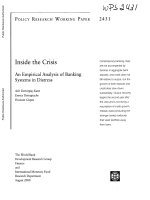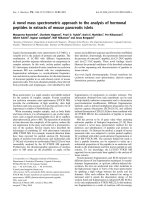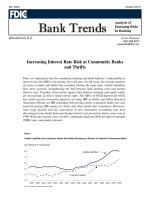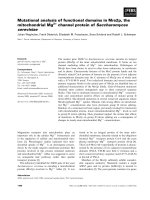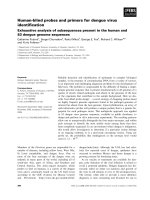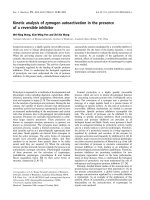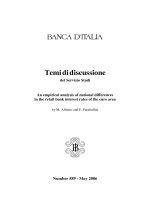Analysis of the corporate behaviors after the corporate tax cuts with respect to job creation: A preliminary study of select corporations in the united states of America
Bạn đang xem bản rút gọn của tài liệu. Xem và tải ngay bản đầy đủ của tài liệu tại đây (128.7 KB, 5 trang )
Accounting and Finance Research
Vol. 8, No. 3; 2019
Analysis of the Corporate Behaviors after the Corporate Tax Cuts with
Respect to Job Creation: A Preliminary Study of Select Corporations in
the United States of America
Narendra Sharma1, Ebere A Oriaku1 & Ngozi Oriaku1
1
Department of Business and Economics, Elizabeth City State University, NC, USA
Correspondence: Ebere A Oriaku, Department of Business and Economics, Elizabeth City State University, 1704
Weeksville Road, Elizabeth City, NC 27909, USA. E-mail:
Received: May 23, 2019
Accepted: June 27, 2019
Online Published: June 28, 2019
doi:10.5430/afr.v8n3p43
URL: />
Abstract
A preliminary study of the impact of tax cuts on job creation was done by studying a random sample of 12 largest
corporations selected from the Fortune 500 companies. The Annual Reports of the 12 sample companies pre-tax cut
and post-tax cut periods were downloaded, and figures tabulated for revenues, property, plant, and equipment (PPE) as
well as employees reported by those companies for both the periods. We found that the revenue increased by an
average of 7.78 percent which showed signs of growth in those companies, but the investment in PPE by the companies
during the same period increased at an average of only 0.32 percent, which indicated that the companies did not divert
the resources they saved in taxes to add capacity. Therefore, the potential for jobs growth was nonexistent or minimal.
Another indicator showed the same outcome as the companies reported their workforce reduced since 2017 by an
average of 0.54 percent.
Keywords: corporate tax cuts, job creation, job growth, tax cuts and jobs act of 2017
1. Background
A $1.5 Trillion tax overhaul was signed into law by President Trump on December 22, 2017, popularly known as
the Tax Cuts and Jobs Act of 2017. The bill was touted as one of the sweeping legislation that would create jobs in the
US. The biggest beneficiaries were the corporations in the US. The top corporate tax rate was decreased from 35
percent to a flat rate of 21 percent. This rate came into effect for corporations for the tax year starting January
1, 2018, and it is a permanent change. Many policymakers believe that corporate tax cuts are directly related to job
creation in capitalist economies, that such notion is axiomatically seen as a cause-and-effect. In many instances,
authorities in economic and policy studies believe that tax-cuts motivate the corporations to spend on investments in
productive assets and which in turn would increase hiring to meet the demands created by a booming economy created
by tax cuts. However, there has not been unquestionable data to support or refute the claims made regarding the impact
of tax cuts. Therefore, this paper will use empirical data to study the data points for the year 2017 (pre-tax cut year) and
2018 (post-tax cut year) to analyze the indicators of job creation and jobs growth by corporations in support or against
the assertion of the policymakers. As the title suggests, it is only a preliminary study as the impact of tax-cuts are
far-reaching and longitudinal.
2. Introduction
It has been more than a year since the $1.5 Trillion tax overhaul was signed into law by President Trump. The general
belief was that it would turbocharge the economy with increasing GDP, it would unleash investments by corporations
in productive assets which will ultimately lead to the creation of more jobs and may accelerate the wage growth for
workers. The report released by US Bureau of Economic Analysis as shown in Fig 1.1 shows that seasonally adjusted
annual growth rates of GDP did not move much in the first quarter of 2018 but peaked in the second quarter of 2018 at
4.2 percent from 2.2 percent in Quarter One and started to deaccelerated to 3.4 percent in Quarter 3 and further slumped
to 2.6 percent in Quarter 4.
Published by Sciedu Press
43
ISSN 1927-5986
E-ISSN 1927-5994
Accounting and Finance Research
Vol. 8, No. 3; 2019
Figure 1. Real GDP: Percentage Change from Preceding Quarter
Source: US Bureau of Economic Analysis (February 2019). U.S. Economy at a Glance Table. Accessed from
on 3-21-2019.
On the other hand, a survey conducted by the National Association for Business Economics (NABE) reported that “a
large majority of respondents—84 percent—indicate that one year after its passage, the 2017 Tax Cuts and Jobs Act
has not caused their firms to change hiring or investment plans” (NABE Business Outlook Survey, 2019). Against
this backdrop, this paper examines the corporate behavior by examining their spending on long-term PPE (like
buildings, factories, equipment, and technology) and number of employees for a sample of 12 randomly selected
Fortune 500 companies in the industrial sector. A comparative study of 2017 Annual Reports with the 2018 Annual
Reports data is made.
3. Literature Review
There have been studies on both sides of the spectrum about the impact of tax cuts. Some studies have reported no
correlation between tax levels and measures of economic performances like income growth, job creation, and firm
formation. Mazeron (2013) noted that there is simply no consensus that cutting taxes boosts economic growth and
create jobs. On the other hand, Phelps (2018) opined that the supporters of tax cut believe that tax cuts will cause
the rate of return to jump which in turn will push the investment activity resulting in productivity to rise. Because it
will stimulate the economy and increase standard output (Romer & Romer, 2010). But we have not seen research
to categorically suggest that tax cuts have generated productivity growth that will ultimately result in job creation
(Phelps, 2018).
Estache and Gersey (2018) studied the impact of changes in the effective corporate tax rate on unemployment rate in
Europe between 1999 and 2014 and reported that a one percent decrease in the effective tax rate was associated with
0.34 percent increase in the unemployment rate on average. They argued that lower corporate income tax rates create
an atmosphere whereby the labor is replaced by capital, which ultimately leads to an increase in unemployment rates.
Mankiw, Weinzierl, and Yagan (2009) expressed their view of optimal tax policy based on the work of Ramsey
(1927) and Murrtee (1971). They believe that flat tax with a universal lump-sum transfer could be close to optimal.
The uniformity in tax policy leads to a better tax result. The authors found that tax policies should maximize social
welfare function subject to a set of constraints. Good tax policy should favor equitable and low incidence. The ability
to pay should also be considered. In this instance, the recent corporate tax policy violates the set of criteria for
optimal tax policy. The assumption that a tax break for corporations should increase employment does not satisfy the
conditions for optimal tax. The study concluded that the flat tax policy seems to be optimal compared with
corporate tax cut policy as a way of increasing employment. Similarly, Donaldson (2018) points out to the fact that
earlier tax reforms (Tax Reform Act of 1986 and 2016 Tax Acts) had adopted policies in a bipartisan manner.
However, Republicans, this time around, came with a way to reform tax code without a bipartisan support with
several changes starting from individual tax reform to more significant part of the consideration to benefit
corporations with corporate tax cuts. Their anticipated solution to the economic problems such as unemployment
may have been farfetched.
Published by Sciedu Press
44
ISSN 1927-5986
E-ISSN 1927-5994
Accounting and Finance Research
Vol. 8, No. 3; 2019
Leigh (2018) studied about 1000 profitable Australian firms to explore the relationship between these firms and job
creation by testing the assertion that if corporate tax rates are reduced, corporations will make profits and will invest
more due to an increase in revenue resulting from low tax rates. However, this study proved the reverse that all the
high-profit firms with reduced tax rates created fewer jobs, which refutes the assumption of President Trump's
corporate tax-cut as a means of increasing available jobs. In the same vein, Jones and Haigh (2007) recognized
corporations as a legal entity existing in contemplation of laws. These corporations are always aiming at maximizing
profits, usually by minimizing costs to accomplish their goals and objectives. They may reduce employment to cut
down cost and improve the profits rather than creating more jobs. The authors argued that there are no indications
that corporations exist to play a welfare role for the society, and if corporate tax rates are reduced, corporations will
enjoy profits by first taking care of corporate executives. Richardson and Lanis (2007) emphasized that the tax rate
reform is generally used by policymakers and interest groups to create incentives for their believers. In respect to
this statement, it can be assumed that the recent US corporate tax cut is deep-rooted in a similar assumption. The
evidence from the Australian model shows a negative association between effective tax rates and measures of firm
size (a proxy for political power theory).
Page, Rosenberg, Nunns, Rohaly, and Berger (2017) argued that the Tax Cut and Jobs Act was supposed to increase
GDP on a macro level by increasing output. The assertion also was that both individuals and businesses would
encounter an increase in disposable income, which would boost the economy resulting in a reduction of the deficit.
However, the authors showed that the act left a lot of promises of tax reforms unfulfilled. For example, the law failed
to present incentives on employment. The bill leaves revenues far below expected to spend specially in the wake of
spending increases enacted before the ink had dried out the Tax Cut and Jobs Act legislation. Despite arguments
supporting corporate tax cuts, the disadvantages have outweighed the supposed advantages. Mertens and Ravn (2013)
studied the estimate of the dynamic effects of changes in personal and corporate income taxes. They discovered that
short-run effects on output of the tax shocks are significant and that it is essential to distinguish between different
types of taxes when considering their impact on the labor market and expenditure components. The authors used
examples from different countries around the world, which showed that none of them benefited economically in the
long run because of corporate tax cut policies.
Auerbach (2018) studied the effects of corporate tax cut under President Trump from two perspectives: a) those who
see the cut as a measure to sustain business and achieve growth in the economy. This group is the team for the current
White House Economic Advisers, and b) an independent group who see no evidence theoretically and practically of
any positive impact on the middle-class wages and economic growth. This group sees it as a measure to benefit the rich
class at the expense of the masses. In its effect will give rise to long run decline of economic growth and negative
growth in labor force. White House Council of Economic Advisers (2017) did a forecast that corporate tax rate of 20%
would lead to a substantial rise in wages. In effect, the prediction was that average household income would rise by
about $4,000. Using theoretical approach, the increase in household income is difficult to measure. Auerbach (2018)
opined that “measuring the potential effects of the legislation requires accounting for myriad other provisions affecting
investment decisions and international activity, which the law substantially altered” (p. 117). The rise in wages of
households therefore becomes a farfetched argument. In an open economy like the U.S, doubts are created on the
feasibility of the argument. Auerbach (2018) argued that there is no empirical evidence that supports the position of the
White House Council of Economic advisers.
Literature has not taken supportive stand on the positive results of the Advisers’ position on the corporate tax cuts.
Several models had been tried across nations, including the United States, that have resulted is a deficit crowd out
which depresses wage growth. This, of course, is the position taken by our paper. At the same time allocation burden of
taxation poses long term impact on deficit, and tax cut designed for the wealthy and corporations deepens capital.
Against the backdrop of the above studies, the current research espouses to establish connections between lower tax
rates, investment by companies in productive assets, and employment numbers to evaluate the impact of tax cuts on
the behaviors of the corporations.
4. Research Method
We collected data from published sources to study the data points for the year 2017 (pre-tax cut year) and 2018
(post-tax cut year) and analyzed the indicators of job creation by corporations in support or against the assertion of the
policymakers.
Published by Sciedu Press
45
ISSN 1927-5986
E-ISSN 1927-5994
Accounting and Finance Research
Vol. 8, No. 3; 2019
4.1 Sample
As the title suggests, it is only a preliminary study of the impact of tax cuts, a random sample of 12 largest corporations
was selected from the Fortune 500 companies (See Appendix 1 for the list of companies) that have published their
financial statements for a full year of operations by the time of the study.
4.2 Data Collection and Variables
The Annual Reports of the 12 sample companies were downloaded, and figures for total revenue and Property, Plant
and Equipment were tabulated. The number of employees reported by these companies before the tax cut and one
year after the tax cut was also tabulated. The total revenue was considered as the proxy for growth and the total PPE as
a proxy to capacity to create jobs by the companies.
5. Findings and Conclusions
At an average the revenue increased by 7.78 percent which showed signs of growth in those companies, but the
investment in PPE by the companies during the same period increased at an average of only 0.32 percent, which
indicated that the companies did not divert the resources they saved in taxes to add capacity, therefore, the potential for
jobs growth. The preliminary findings suggest that large companies continued to show signs of growth but did not
add much to the capacities to create more jobs. In fact, the companies reduced their workforce since 2017 by an
average of 0.54 percent.
In analyzing the impact of corporate tax cut as a policy geared towards improving the economy as well as the welfare of
the masses, an economic cost benefit analysis will aid the policy maker in accepting or rejecting the policy. The
analysis will also justify the impact of the policy on the economy as a whole, not on a small sector. According to
Gittinger (1982), if the economic benefit exceeds economic cost, the policy should be adopted. On the other hand, if the
economic cost exceeds the economic benefit, the project is unacceptable. From the result of the research and based on
its impact on employment, the claim of the corporate tax cut definitely does not meet its expectations. This policy that
has been adopted, will have a negative impact on the whole economy in the long run. Our study results agree with
Auerbach (2018) and illustrate that the claim of the White House corporate Tax cut has no evidence of job growth and
even there was any, it is difficult to test empirically. The initial little increase in wages will outweigh resulting more
taxes to middle class in the long run.
6. Suggestions for Further Research
Tax cuts and job creation have been touted as positively correlated, but this study failed to support that hypothesis.
However, the study is limited in the sample size and number of years that have been studied. A longitudinal study with
a larger sample size may give a better idea about this important correlation. It may also be possible that the results are
eschewed because of international operations these sampled companies are engaged.
References
Auerbach, A. A. (2018). Measuring the effects of corporate tax cuts. Journal of Economic Perspectives, 32(4),
97-120. />Donaldson, S. A. (2018). Understanding the tax cuts and jobs act. GA: Georgia State University College of Law,
Legal Studies Research Paper no. 2018-07. />Estache, A., & Gersey, B. (2018). Do corporate income tax rates cuts create jobs? The European experience. ULB -Universite Libre de Bruxelles. Retrieved from />Gittinger, J. P. (1982). Economic analysis of agricultural project (2nd ed.). Baltimore: John Hopkins University Press.
Jones, M. T., & Haigh, M. (2007). The transnational corporation and new corporate citizenship theory: A critical
analysis.
The
Journal
of
Corporate
Citizenship,
27(Autumn),
51-69.
/>Leigh, A. (2018). Do firms that pay less company tax create more jobs? Economic Analysis and Policy, Elsevier,
59(C), 25-28. />Mankiw, N. G., Weinzierl, M., & Yagan, D. (2009). Optimal taxation in theory and practice. Journal of Economic
Perspectives, 23(4), 147-174. />Mazerov, M. (2013). Academic research lacks consensus on the impact of state tax cuts on economic growth: A reply
to
the
tax
foundation.
Center
on
Budget
and
Policy
Priorities.
Retrieved
from
Published by Sciedu Press
46
ISSN 1927-5986
E-ISSN 1927-5994
Accounting and Finance Research
Vol. 8, No. 3; 2019
/>c-growth
Mertens, K., & Ravn, M. O. (2013). The dynamic effects of personal and corporate income tax changes in the united
states. American Economic Review, 103(4), 1212-47. />Page, B. R., Rosenberg, J., Nunns, J. R., Rohaly, J., & Berger, D. (2017). Macroeconomic analysis of the tax cuts
and jobs act (Research Report). Washington D.C.: Tax Policy Center, Urban Institute, and Brookings Institution.
Retrieved
from
/>s_and_jobs_act_conference_12-20.pdf
Phelps, E., (2018). America’s policy thinking in the age of trump. Journal of Policy Modeling, 40(3), 509-514.
/>Richardson, G., & Lanis, R., (2007). Determinants of the variability in corporate effective tax rates and tax reform:
Evidence from Australia. Journal of Accounting and Public Policy, 26(6), 689-704.
/>Romer, C. D., & Romer, D. H., (2010). The macroeconomic effects of tax changes: Estimates based on a new
measure of fiscal shocks. American Economic Review, 100(3), 763-801. />US Bureau of Economic Analysis (February 2019). U.S. Economy at a Glance Table. Accessed from
on 3-21-2019
Appendix 1
AT&T
Boeing
Chevron
ExxonMobil
Ford Motors
GE
General Motors
IBM
Johnson and Johnson
McKesson
Valero
Walmart
Published by Sciedu Press
47
ISSN 1927-5986
E-ISSN 1927-5994



